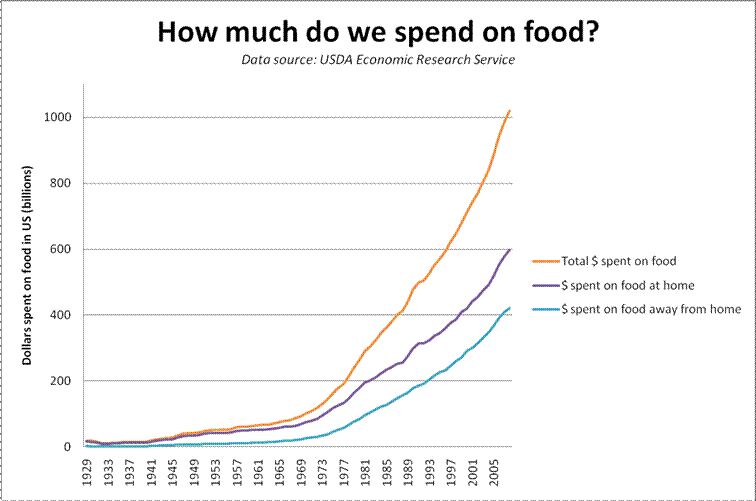In an article last week, I discussed data that shows that a farmer receives a dwindling portion of the consumer food dollar in the US. The data does not explain the ratio of whole foods to processed or prepared foods purchased, but one person who commented on that post attempted to reason, “The farmers’ share has fallen because consumers are choosing to eat out more and buying food in more highly processed forms. If we all want to return to buying raw food at markets and spending hours preparing it then the farmers’ share can go up.” This is an understandable, if uninformed, take on why farmers aren’t winning in the current food economy, but it misses what’s really going on: Americans spend significantly more money on food they eat at home than they do on food they eat out.
 In the US, the food-at-home market is larger than the food-away-from-home market
In the US, the food-at-home market is larger than the food-away-from-home market
Since 1929, when the USDA dataset begins, disposable income spent on food-away-from-home has increased more than five times faster than has disposable income spent on food-at-home. There is no question that the market for restaurants, prepared food, and food service blew up in the second half of the twentieth century. But the food-at-home market is still 42% bigger than the market for food that is consumed away from home, and it has been that way since the early 2000s. Furthermore, the ratio of dollars spent on food-at-home to dollars spent on food-away-from-home has been especially stable in recent years. Cathy Erway and her ilk, who are trying to shift even more consumption back into the home, might take comfort in that statistic, even if they have a lot of territory to cover to get us back to our early-1900s habits. Even in this era of idolizing chefs, restaurants, and food experiences, we still spend more money on food that we eat at home than we do on food outside of the home.
That means that the data to which I referred last week is not just a reflection of people paying someone else to prepare their food. I posit that what is really going on is that stale supply chains make it nearly impossible for farmers to reach consumers, and that because of the lack of choice in market channels, consolidators, wholesalers, and distributors can earn a huge amount of money, even though most on-lookers would say they don’t add a whole lot of value. Those intermediaries skew the portion of the consumer dollar that goes to the farmer for producing the food, tending the land that gave up that food, and managing the risk and decisions involved with sustaining a crop.
In response to intermediaries eating into food dollars, farmers have attempted to reach consumers directly through farmers’ markets and CSAs, and consumers show a growing interest in forging that connection with the farm and their food. That the number of farmers’ markets in the US has increased 114% in the last decade, to 6,132 markets around the country, suggests that consumers have an interest in getting their whole dollar to the farmer, rather than paying a store to keep its lights on.
Consumers, take comfort. You have a direct hand in farmers getting more of the credit for the food you eat. But you have to start with knowing whom you empower to feed you.
This post originally appeared at www.zocalofood.com/blog
Elizabeth McVay Greene is a founder of Zocalo, and focuses on the role that technology can have in enabling a healthier food system, for people and the environment.


